The automatic start and stop systems will be part of the way car makers are meeting the tighter emission standards for the foreseeable future.
Whether you like the Start/Stop feature or not, you should get to know these systems because the automatic start and stop systems will be part of the way car makers are meeting the tighter emission standards for the foreseeable future.
These systems were first introduced in some hybrid cars as a way to switch from the combustion engine to the electric motor/generator systems.
Volvo first introduced their version of Start/Stop technology in 2009 in cars with their Drive-E branding.
Start/Stop systems were developed as a way for auto makers to help reduce emissions and increase overall fuel efficiency.
A lot of unnecessary hydrocarbons and other ozone depleting emissions are generated all over the world by cars idling in traffic every day.
And then there’s the wasted fuel. A study that was done in 2012 stated that in the United States alone, idling wastes approximately 3.9 billion gallons of gasoline per year.
Some states have passed laws pertaining to idling, setting time limits on excessive idling, especially in places like loading zones and places where the vehicle will be parked or stationary for more than a few minutes.
Cars that are equipped with Start/Stop systems have different support components and electrical systems than cars with conventional drivetrains.
Modified electrical demands in cars with Start/Stop systems
During the Start/Stop or Auto Stop function, the standby battery supplies power to all the electrical accessory demands, including the air conditioning, radio (infotainment system), interior cooling fan, electric water pump, wipers, lighting, etc.
During a Start/Stop event, the battery can be drained to a predetermined level before the battery monitoring module would command the starter to engage and restart the engine.
Vehicle system modifications
Many vehicle alterations had to be made to standard engine parts to make Start/Stop systems practical; we could never achieve the same desired effect by turning off the engine manually.
First off, the starter motor has to be a lot more robust so it will stay reliable, despite being used far more often than a conventional starter motor.
The batteries for these cars have to be the deep cycle type, that can endure more frequent draws from the starter. They also have to maintain power to the accessories like the electric water pump for the engine coolant when the engine is in the Stop mode.
Electric pumps are also necessary to maintain hydraulic pressure to the transmission when the engine is in Stop mode, so there is no felt power loss when the driver steps on the accelerator and the engine restarts and the car starts to move forward.
Most problems that technicians are seeing with Volvo Start/Stop systems stem from the batteries or, in rare cases, the starter motor.
These systems would not work with some standard engine components because of the extra load being put on, not just the starter motor, but many other drivetrain components as well.
Auto makers had to redesign many of the existing internal combustion engine components and come up with a few new ones to handle these systems. For example, cooling systems had to include electric water pumps so the coolant would still be flowing when the engine was in the stop part of the cycle.
Customer education
A lot of customer complaints with the Start/Stop system will end up being lack of knowledge of how these systems work.
Your customers will come to you with all kinds of perceived problems with the Start/Stop function and insist that it was not working right.
The customer may not even know what “working right” means.
This happens a lot, especially when two people share one car. That’s because most people have totally different driving styles.
One person may have the habit of switching off the Start/Stop function every time they drive the car, while the other driver may not even know there is an option to do this.
Pandemic problems
The pandemic has brought about a lot of challenges in our world, in all areas of our lives.
The work-from-home culture has changed the way your customers drive and maintain their cars. Your shop has probably seen a large number of cars being towed in with battery problems due to customers letting their cars sit idle for days and weeks at a time.
This is fine if your customer has an old pre-CAN bus network car, but this is not the case with any car made after the year 2000.
The CAN bus network communication can continue even when the car is dormant for days. Not all nodes will go to sleep and stay asleep, and this can cause the battery to drain.
Volvo vehicles are no exception. Even if the main battery is able to start the engine, the Start/Stop may not function due to the small standby battery being discharged.
Volvo vehicles like to be driven.
How the Start/Stop system works on Volvo vehicles
Driving with Start/Stop function
The Start/Stop function temporarily switches off the engine when stationary and then restarts it automatically when the journey is resumed.
The Start/Stop function is available when the car is started and can be activated if certain conditions have been met.
The driver display indicates when the function is:
- Available
- Active
- Not available
All of the car’s normal systems such as lighting, radio, etc. work normally, even when the engine is auto-stopped. However, some equipment may have its output temporarily reduced, such as the climate control system’s fan speed or extremely high volume on the audio system.
Auto-stop
The following is required for the engine to auto-stop:
- Stop the car with the foot brake and then keep your foot on the brake pedal – the engine stops automatically.
- In drive mode Comfort or Eco, the engine may auto-stop before the car is completely stationary.
- With adaptive cruise control or Pilot Assist activated, the engine will auto-stop after approximately three seconds.
Auto-start
The following is required for the engine to auto-start:
- Release the brake pedal – the engine will auto-start and you can continue driving.
- On an uphill gradient Hill Start Assist (HSA) engages, which prevents the car from rolling backwards.
- When the Auto Hold function is activated, auto-start is delayed until the accelerator pedal is depressed.
- When adaptive cruise control or Pilot Assist is activated, the engine will auto-start when the accelerator pedal is depressed, or by pressing the button on the left keypad of the steering wheel.
- Maintain foot pressure on the brake pedal and depress the accelerator pedal — the engine auto-starts.
- On a downhill gradient: Release pressure on the brake pedal slightly so that the car begins to roll — the engine will auto-start after a slight speed increase.
Symbols in the instrument panel

If no symbol is shown, the function is switched off.
With 12-inch driver display
- A pointer in the tachometer points to READY when the function is active and the engine is auto-stopped.
- No text is shown when the function is deactivated.
Conditions for the Start/Stop function
For the Start/Stop function to work, a number of conditions must be met.
If any condition is not met, this will be indicated in the driver display.
The engine does not auto-stop
The engine does not auto-stop in the following cases:
- The car has not reached approximately 6 mph after starting.
- After a number of repeated auto stops, speed must again exceed approximately 6 mph before the next auto-.
- The driver has unfastened the seat belt.
- The capacity of the starter battery is below the minimum permissible level.
- The engine is not at normal operating temperature.
- The ambient temperature is below approximately 23°F (-5°C) or above approximately 86°F (30°C).
- The windscreen’s electric heating is activated.
- The environment in the passenger compartment deviates from the set values.
- The car is reversed.
- The starter battery’s temperature is below or above the permitted limit values.
- The driver makes sweeping steering wheel movements.
- The road is very steep.
- The hood is opened.
- When driving at high altitudes when the engine has not reached operating temperature.
- The ABS system has been activated.
- In the event of heavy braking (even without the ABS system having been activated).
- Many starts during a short period of time have activated the starter motor’s thermal protection.
- The exhaust system’s particulate filter is full.
- A trailer is connected to the car’s electrical system.
- The gearbox is not at normal operating temperature.
- The gear selector is in M (±) position.
The engine does not auto-start
In the following cases the engine does not auto-start after having auto-stopped:
- The driver is unbelted, the gear selector is in P position and the driver’s door is open. A normal start must take place.
The engine auto-starts without the brake pedal having been released
In the following cases, the engine auto-starts even if the driver does not take his/her foot off the brake pedal:
- High humidity in the passenger compartment forms misting on the windows.
- The environment in the passenger compartment deviates from the set values.
- There is a temporarily high current take-off, or starter battery capacity drops below the lowest permissible level.
- Repeated pumping of the brake pedal.
- The hood is opened.
- The car starts to roll or increase speed slightly if the car auto-stopped without being completely stationary.
- The driver’s seat belt buckle is opened with the gear selector in D or N position.
- The gear selector is moved from D to R or M (±) position.
- The driver’s door is opened with the gear selector in D position — a “ping” sound and text message indicate that the ignition is on.
Warning
Do not open the hood when the engine has auto-stopped. Switch off the engine normally before lifting up the hood.
The Start/Stop function is disabled if the support battery is weak or the voltage is out of range.
Using VIDA to diagnose Start/Stop problems

Volvo’s Service, Parts and Diagnostic Application VIDA (Vehicle Information and Diagnostics for Aftersales) is one of the best tools to diagnose issues with the Volvo auto-Start/Stop system.
You can use VIDA to see all kinds of useful data and run active testing on the system.
Even if there are no codes stored at the time you check the car, the CEM will record and store a lot of data PIDs.
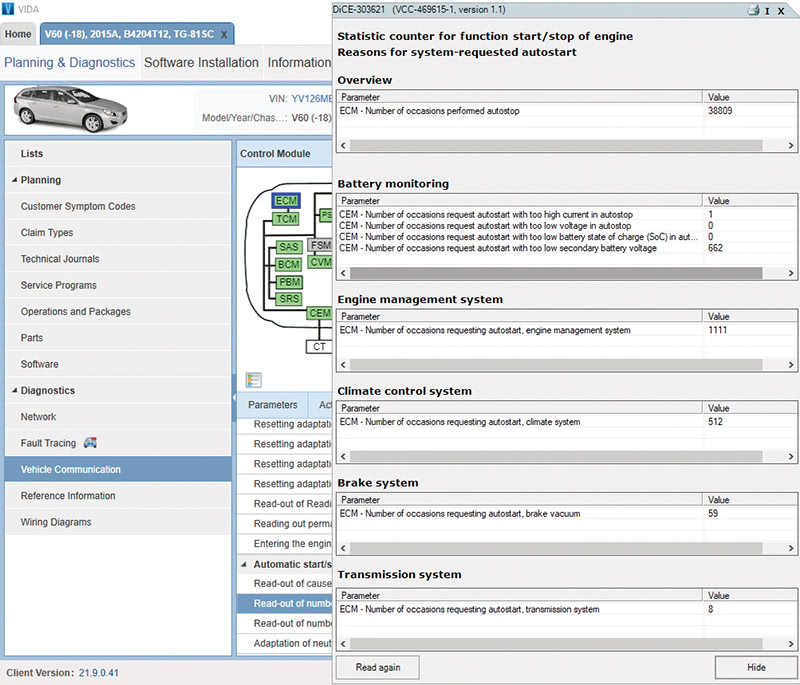
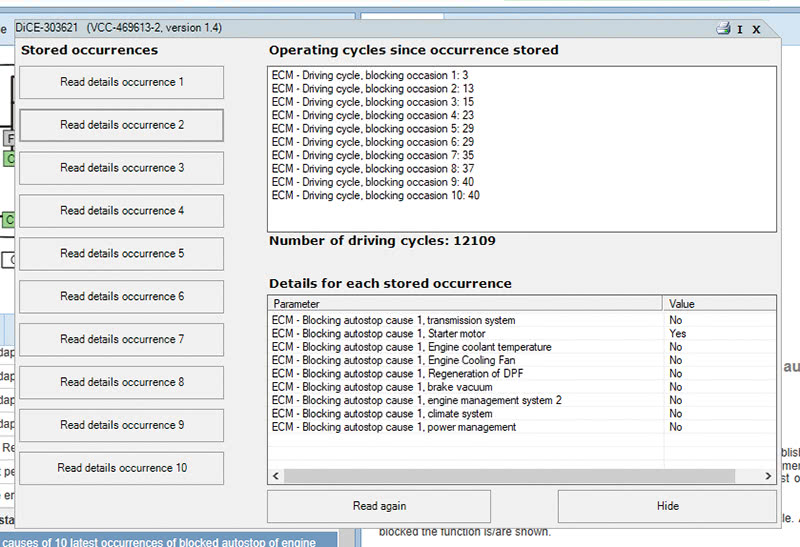
One of the most common causes of problems with the Volvo automatic Start/Stop system stems from problems with the batteries. Yes, batteries, plural.
All Volvo vehicles that come equipped with the automatic Start/Stop system have two batteries — a main battery and a small standby battery. The standby battery’s main purpose in life is to run the car’s functions when the engine is off and in standby mode.
The support battery is located in different locations depending on model and year. Be sure to reference VIDA to find locations.
Volvo battery testing
Volvo states that checking the status of the batteries on SPA/CMA and P3 models should be done by the onboard battery monitoring sensor and related battery systems.
That’s unless the driver sees a battery warning displayed in the DIM screen.
The standby battery is an AGM battery that is specifically designed by Volvo engineers for this purpose.
Follow these steps as outlined in Volvo TJ26745.13.9.
AGM-type batteries are very sensitive to charging conditions:
- A charging voltage of 13.6 volts is preferred.
- Charging voltage MUST NOT exceed 14.4 volts.
- Charge current into battery should not exceed 25 amps.
- Midtronics MSP-070 should never be set to 14.4 volts with AGM batteries.
- Exceeding the recommended charging voltage or current can permanently damage the battery.
Main Battery Testing: SPA/CMA vehicles only
A new battery diagnostic sequence has been implemented in VIDA that can be used for any situation where the vehicle battery needs to be checked. This includes situations with a customer complaint and general maintenance checkups.
The sequence can be found by following CSC fault tracing for “Electrical distribution: 12V System.”
This new sequence will evaluate the battery condition based on long-term data measured by the vehicle’s
on-board battery diagnostics.
If a deeper analysis of the battery is needed or if the battery is suspected to be faulty, VIDA will guide the technician through the testing procedure and provide a warranty authorization code if the battery needs to be replaced.
| NOTE |
|---|
| The VIDA diagnostic tool is the only acceptable test on SPA/CMA vehicles without a customer complaint or for Multi-Point Inspections (MPI). |
Main Battery Testing: All other vehicles + Support Battery Testing, ALL Vehicles
The hand-held battery tester (9513030/BT3300) should be used for testing main batteries on all non-SPA/CMA vehicles and for testing support batteries on ALL vehicles. Before testing battery, read out the vehicle with VIDA to ensure that there are no current issues causing battery drain. Please follow normal CSC-based fault tracing to determine if battery testing is needed.
| NOTE |
|---|
| The hand-held battery tester must be set to test the appropriate type of battery: If the Volvo label on top of the battery indicates “AGM,” then the “AGM Flat-Plate” setting should be selected. All others should use the “Regular Liquid” setting. |
The tester should also be set to the “EN” (European Normal) rating scale as indicated on the Volvo label.
The hand-held tester must ALWAYS be connected directly to the battery terminals for testing. Connecting the negative clamp to a grounding point is not acceptable.
Don’t take a chance by replacing this very important battery with an inexpensive replacement or one that “looks close enough.” Make sure you replace it with an OE Volvo replacement battery from your local dealership parts department.
When replacing the standby battery, it is important to make sure the main battery is in good shape too. It is more common to replace both batteries as a pair.


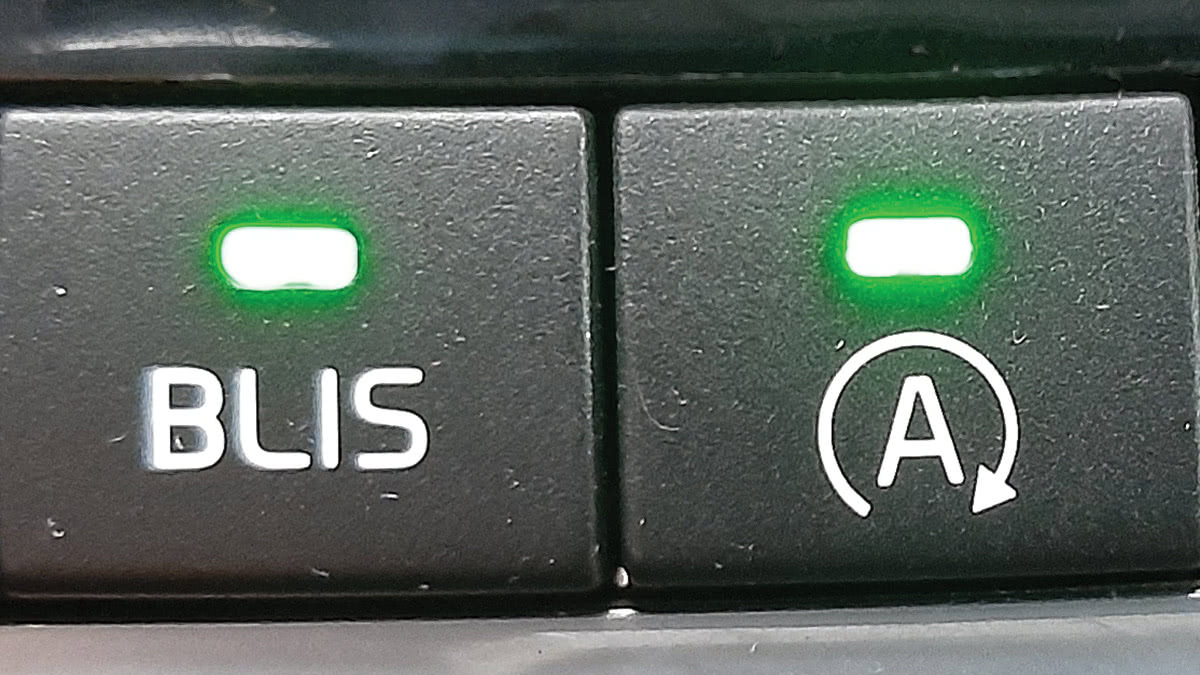


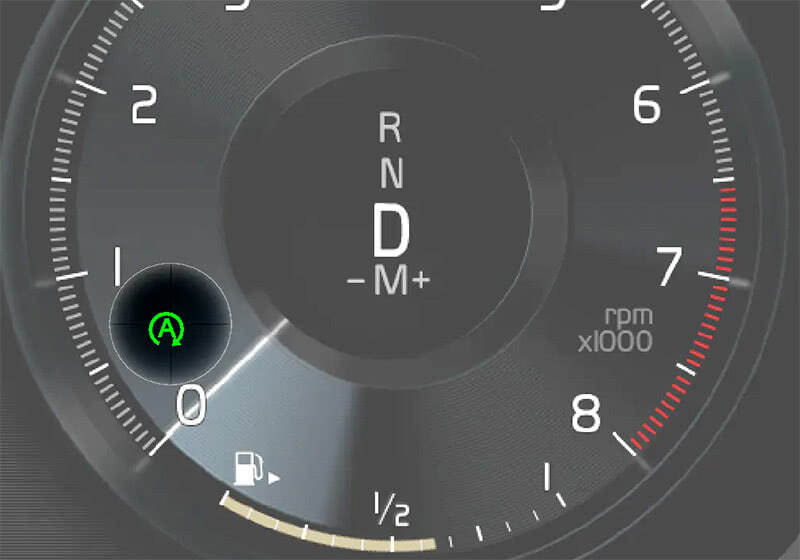
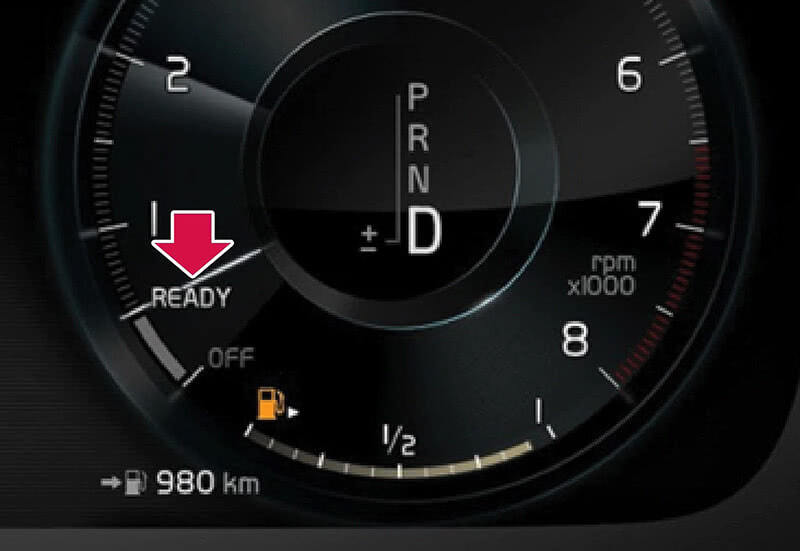

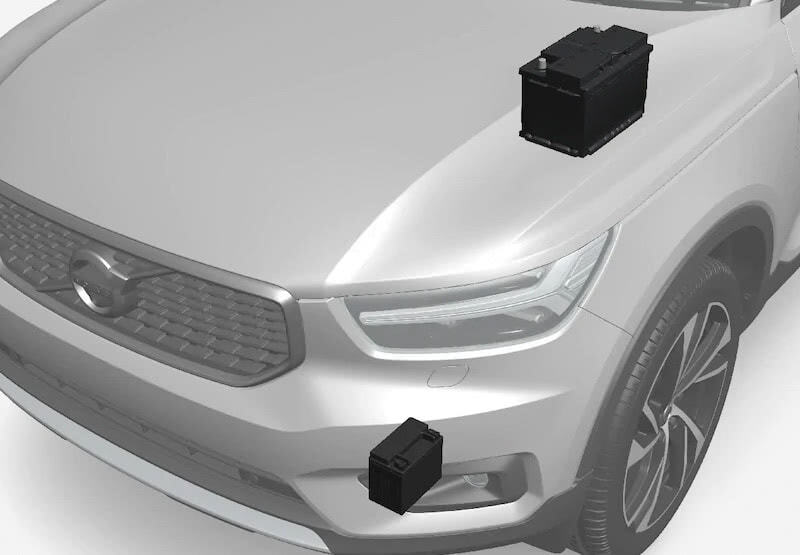





0 Comments